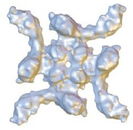| Record Information |
|---|
| Version | 2.0 |
|---|
| Creation Date | 2009-07-03 22:19:01 UTC |
|---|
| Update Date | 2014-12-24 20:25:37 UTC |
|---|
| Accession Number | T3D2500 |
|---|
| Identification |
|---|
| Common Name | alpha-Latrotoxin |
|---|
| Class | Protein |
|---|
| Description | Latrotoxins are the main active components of the venom of spiders of the genus Latrodectus (widow spiders). They are neurotoxins and are responsible for the symptoms of latrodectism. The best-studied latrotoxin is alpha-latrotoxin, which acts presynaptically to release neurotransmitters from sensory and motor neurons, as well as on endocrine cells. (2) |
|---|
| Compound Type | - Amide
- Amine
- Animal Toxin
- Natural Compound
- Organic Compound
- Protein
- Spider Toxin
|
|---|
| Protein Structure |  |
|---|
| Synonyms | | Synonym | | a-Latrotoxin | | a-LTX | | alpha-LTX |
|
|---|
| Chemical Formula | Not Available |
|---|
| Average Molecular Mass | 156855.500 g/mol |
|---|
| CAS Registry Number | 65988-34-3 |
|---|
| Sequence | Not Available |
|---|
| Chemical Taxonomy |
|---|
| Description | Not Available |
|---|
| Kingdom | Organic Compounds |
|---|
| Super Class | Organic Acids |
|---|
| Class | Carboxylic Acids and Derivatives |
|---|
| Sub Class | Amino Acids, Peptides, and Analogues |
|---|
| Direct Parent | Peptides |
|---|
| Alternative Parents | Not Available |
|---|
| Substituents | Not Available |
|---|
| Molecular Framework | Not Available |
|---|
| External Descriptors | Not Available |
|---|
| Biological Properties |
|---|
| Status | Detected and Not Quantified |
|---|
| Origin | Exogenous |
|---|
| Cellular Locations | Not Available |
|---|
| Biofluid Locations | Not Available |
|---|
| Tissue Locations | Not Available |
|---|
| Pathways | Not Available |
|---|
| Applications | Not Available |
|---|
| Biological Roles | Not Available |
|---|
| Chemical Roles | Not Available |
|---|
| Physical Properties |
|---|
| State | Liquid |
|---|
| Appearance | Clear solution. |
|---|
| Experimental Properties | | Property | Value |
|---|
| Melting Point | Not Available | | Boiling Point | Not Available | | Solubility | >10 mg/mL | | LogP | Not Available |
|
|---|
| Predicted Properties | Not Available |
|---|
| Spectra |
|---|
| Spectra | | Spectrum Type | Description | Splash Key | Deposition Date | View |
|---|
|
|---|
| Toxicity Profile |
|---|
| Route of Exposure | Injection (sting/bite) (4) |
|---|
| Mechanism of Toxicity | alpha-Latrotoxin acts presynaptically to release neurotransmitters from sensory and motor neurons, as well as on endocrine cells. alpha-Latrotoxin tetramers can form ion-permeable pores in the membrane of target cells, causing influx of calcium ions and thus leading to massive release of the neurotransmitters acetylcholine, norepinephrine, and GABA. alpha-Latrotoxin insertion requires the receptors neurexin, latrophilin, and protein tyrosine phosphatase sigma. alpha-Latrotoxin interactions with latrophilin is also believed to have other signalling-related actions. (2) |
|---|
| Metabolism | Free toxin may be removed by opsonization via the reticuloendothelial system (primarily the liver and kidneys) or it may be degraded through cellular internalization via the lysosomes. Lysosomes are membrane-enclosed organelles that contain an array of digestive enzymes, including several proteases. |
|---|
| Toxicity Values | LD50: 0.90 mg/kg (Subcutaneous, Mouse) (1) |
|---|
| Lethal Dose | Not Available |
|---|
| Carcinogenicity (IARC Classification) | No indication of carcinogenicity to humans (not listed by IARC). |
|---|
| Uses/Sources | Latrotoxins are the main active components of the venom of spiders of the genus Latrodectus (widow spiders). (2) |
|---|
| Minimum Risk Level | Not Available |
|---|
| Health Effects | alpha-Latrotoxin causes a condition called latrodectism, which results from the venom acting at nerve endings to prevent relaxation of muscles, causing tetany (constant, strong, painful muscle contractions). Although severe symptoms such as shock and coma are known to have happened, death due to latrodectism is rare. (3) |
|---|
| Symptoms | Symptoms of latrodectism include pain in muscle groups local to the bite, muscle cramping, headache, dizziness, tremors, salivation, diaphoresis, nausea and vomiting, anxiety, fatigue, insomnia, lacrimation, joint pain, tachycardia or bradycardia, restlessness, hypertension, and tachypnea. (3)
|
|---|
| Treatment | Treatments for latrodectism usually involve symptomatic therapy with pain medication, muscle relaxants, and antivenom. (3) |
|---|
| Normal Concentrations |
|---|
| Not Available |
|---|
| Abnormal Concentrations |
|---|
| Not Available |
|---|
| External Links |
|---|
| DrugBank ID | Not Available |
|---|
| HMDB ID | Not Available |
|---|
| PubChem Compound ID | Not Available |
|---|
| ChEMBL ID | Not Available |
|---|
| ChemSpider ID | Not Available |
|---|
| KEGG ID | Not Available |
|---|
| UniProt ID | P23631 |
|---|
| OMIM ID | |
|---|
| ChEBI ID | Not Available |
|---|
| BioCyc ID | Not Available |
|---|
| CTD ID | Not Available |
|---|
| Stitch ID | Alpha-latrotoxin |
|---|
| PDB ID | Not Available |
|---|
| ACToR ID | Not Available |
|---|
| Wikipedia Link | Not Available |
|---|
| References |
|---|
| Synthesis Reference | Not Available |
|---|
| MSDS | Not Available |
|---|
| General References | - Bettini S (ed) (1978). Athropod Venoms Vol IIL of Handbook of Experimental Pharmacology. Berlin: Springer.
- Wikipedia. alpha-latrotoxin. Last Updated 14 May 2009. [Link]
- Wikipedia. Latrodectism. Last Updated 12 May 2009. [Link]
- Wikipedia. Spider toxin. Last Updated 9 January 2009. [Link]
|
|---|
| Gene Regulation |
|---|
| Up-Regulated Genes | Not Available |
|---|
| Down-Regulated Genes | Not Available |
|---|

